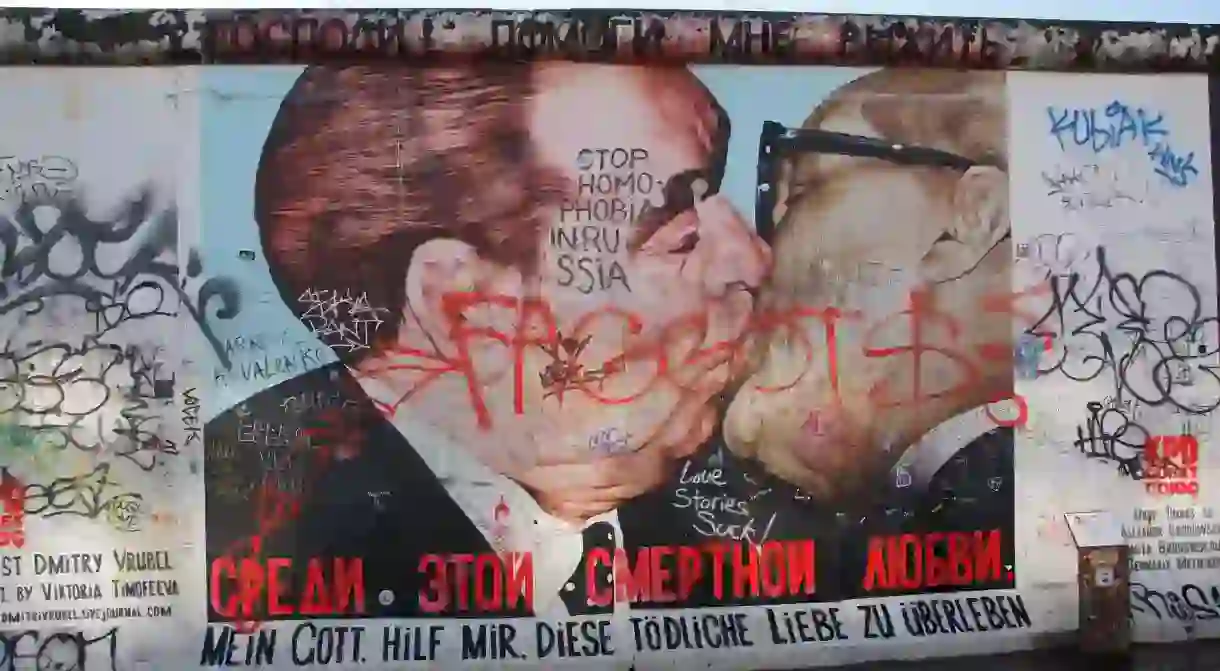Exploring Berlin's East Side Gallery

Since the fall of the Berlin Wall on November 9th, 1989, the cement segments that remain have stood as something more symbolic than just a wall. With installations in every continent, except for Antarctica, the East Side Gallery is the most authentic existing part of the Berlin Wall.

The East Side Gallery is one of Berlin’s most historic landmarks that has also been turned into an artistic landmark. The gallery is located on Muehlenstrasse and is accessible from both Warschauer Strasse and Ostbanhoff. The 1.3 kilometre part of the Berlin Wall is the longest part that is still largely intact. The East Side Gallery is visited at all times of the day and night by visitors, locals, and people spilling out of the nearby clubs, such as Berghain or Watergate. Across the road sits Berlin’s largest arena, the Mercedes Benz Arena, which is used for many events in the city ranging from ice hockey to sold out concerts.

The East Side Gallery is located on the Spree at the former borders of the Soviet and American sector, next to the Oberbaumbrücke, which is one of the most historically important bridges in Berlin. Access via this border crossing was restricted to West Berlin citizens, unlike some other areas that were open to West German citizens as well. The bridge is what separates the kiez (a Berlin slang word for neighborhood) of Kreuzberg and Friedrichshain from one another. Friedrichshain was part of the East, also know as the DDR (Deutsche Demokratische Republik), while Kreuzberg belonged to the West.
Contrary to popular belief, there was not just one single wall built up when Berlin was divided, but many obstacles and multiple walls were constructed. The wall went through four major redesigns during its almost 30 year existence. This part of the wall was built in 1975 and is the most commonly known structure of the wall. The 3.6 meter high barrier was known as the Grenzmauer 75 and lasted 14 years before its ultimate destruction. The Mauer museum located in Prenzlauerberg is another outdoor free exhibit that provides more information about the Berlin Wall and shows what it looked like during former times.

The 101 murals along the wall were created by 118 artists from 21 countries. During the years that the Berlin Wall was erected, graffiti covered the West side of the wall, but the East was bare, due to its inaccessibility. This adds more significance to the East Side Gallery, which has murals strictly on the east side, something that was never possible before. The gallery was established one year after the fall of the Berlin Wall. One of the more famous pieces includes the mural by Dmitri Vrubel of Leonid Brezhnev (the former General Secretary of the Communist Party of the Soviet Union), and Erich Honecker (the former General Secretary of the Socialist Unity Party) kissing. The kissing mural is titled ‘Mein Gott hilf mir, diese tödliche Liebe zu überleben’, which translate to ‘My God help me to survive this deadly love’. Birgit Kinder’s mural of the Trabi breaking through the wall is also very popular . The Trabant, nicknamed Trabi, was the most common car in East Germany.

In 2013, part of the wall was destroyed at the East Side Gallery in order to build deluxe apartments on the site. The construction did not go without protest and David Hasselhoff even added his voice to the cries of protest. Protesters postponed the 23 meter destruction of the wall, but in the end the murals were moved across the street and preserved.
As of 2015, a fence has been built in order to preserve the wall and prevent vandalism that is quite frequent on this part of the wall. The artists originally painted their murals in 1990 but these have been restored over time. The East Side Gallery is definitely worth a stop by when in Berlin, both for locals and tourists. With over 3 million visitors a year, it stands as a monument to the former division of Berlin and its many murals depict former times of struggle and restriction.













